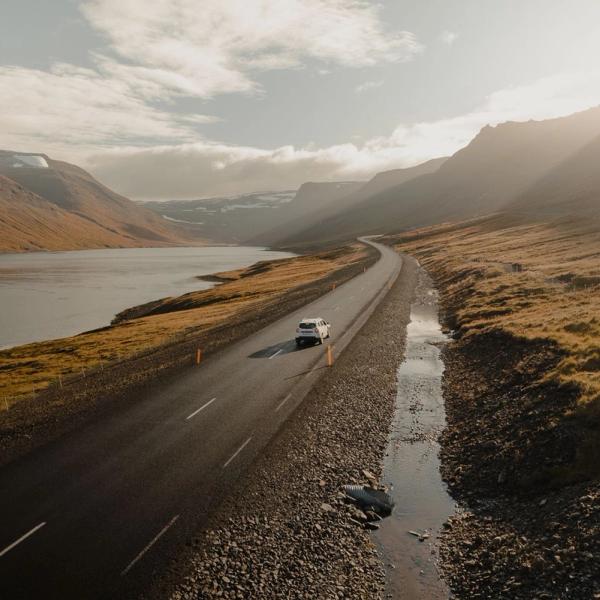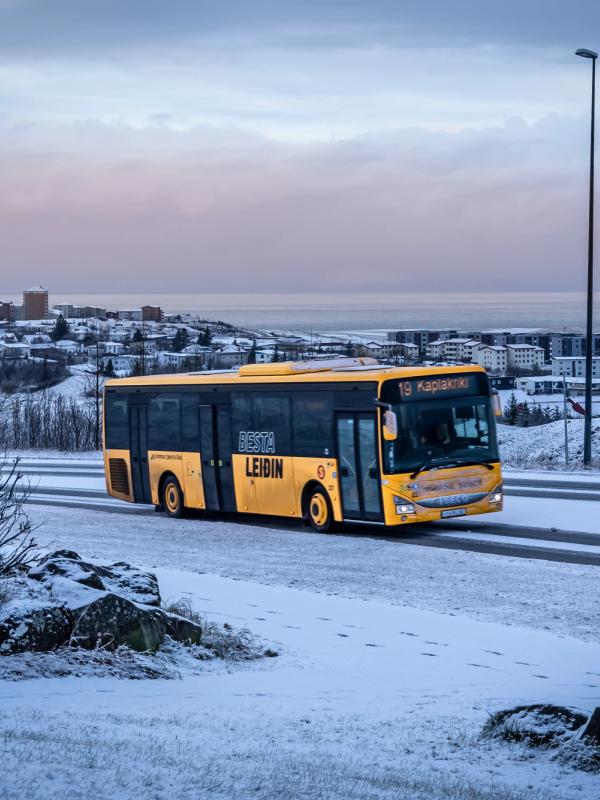
Public Transport in Iceland: The Complete 2025 Guide
Iceland's landscapes of volcanoes, glaciers, and hot springs draw travelers from around the world. Getting around this island comes with challenges, but there’s a way for everyone, especially if you’re willing to put in some effort.
If you're planning an Iceland trip and wondering about transport options, here's what you need to know: buses are Iceland's only true public transport system. Ferries and domestic flights are available to everyone but are privately run rather than publicly funded, and there’s no railroad system.
This guide covers everything about getting around Iceland in 2025 without a car, from bus routes and schedules to tips that will save you time and money.
Overview of Public Transport in Iceland
In Iceland, public transport essentially refers to the Strætó bus system, a publicly funded company managed by Strætó bus. This network mainly serves the Reykjavík Capital Region but also runs select routes connecting major towns and Akureyri.
Two other local bus systems also count as public transport: the SVA system in Akureyri (northern Iceland's largest city) and the local buses in Reykjanesbær near Keflavík International Airport.
Iceland's rugged geography and weather have limited public transport development. With 12,869 km of roads and only 35%-40% paved, getting around without a car can be tricky. Still, Strætó provides essential mobility for locals and tourists, especially in cities.
Non-Public Transport Options
Ferries and domestic flights fill crucial gaps in the transport network despite being privately or semi-privately run. Ferries connect the mainland to islands like Vestmannaeyjar and Hrísey, while domestic flights from Air Iceland Connect and Eagle Air link Reykjavík to regional centers.
Several groups oversee transport in Iceland. The Icelandic Transport Authority handles safety rules, while Vegagerðin (Icelandic Road and Coastal Administration) manages Iceland's road network. Local municipalities fund and oversee Strætó and local bus systems.
Common Challenges of Public Transport
When using public transport in Iceland, be ready for weather-related service changes, especially in winter when roads may become impassable. Fares are higher than in other European countries, reflecting the cost of maintaining transport in challenging terrain.
Rural areas often have limited or seasonal services, so planning ahead for trips outside cities is essential, or even having backup plans.
The biggest downside of public transport compared to having your own campervan is that, even when you can reach your final destination, you will miss all the stops in the middle, which is what makes Iceland a truly special place. Plus, you won't be able to reach remote areas or attractions unless you join a guided tour.
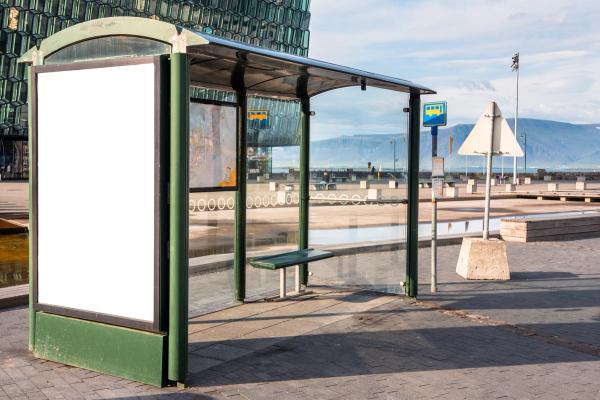
Strætó Buses: Iceland's Public Transport Backbone
The Strætó bus system forms the core of Iceland's public transport network, with good coverage in Reykjavík. Here's what you need to know about using these buses in 2025:
Reykjavík Capital Region
Strætó runs 27 routes throughout the Capital Region, connecting Reykjavík with nearby areas like Kópavogur, Hafnarfjörður, and Garðabær. Buses typically run from 6:30 AM on weekdays (later on weekends) until around midnight.
Key routes include Route 1, which connects downtown Reykjavík (Hlemmur) to Hafnarfjörður for shopping trips, and Route 6, which links Hlemmur to Ártún, serving eastern Reykjavík. For night travel, Routes 101, 103, and 106 run on Friday and Saturday nights.
A single ticket costs 670 ISK (about $4.20 USD) and works for 75 minutes from the moment it’s activated. You can buy tickets through the Klappið app, with cash or card on the bus, or at select stations.
For tourists, the Reykjavík City Card offers unlimited bus travel, museum entry, and discounts, making it a good value for city exploring. You can buy it for 24h ($45), 48h ($63), and 72h ($77).
Here you can check all the routes and timetables in the capital area.
Intercity Connections
Strætó runs several important intercity routes, connecting major towns and tourist spots. From the airport, you can use Route 55 between Reykjavík and Keflavík International Airport, which runs daily with flight schedules for 2,400 ISK one-way (about $17 USD).
In South Iceland, Route 51 goes from Reykjavík to Jökulsárlón Glacier Lagoon via Vík and Skaftafell, a key tourist route running every day during the summer. One-way fares from Reykjavík to Vík cost 8,400 ISK (about $59 USD), while going all the way to Höfn costs 17,400 ISK (about $122 USD).
For those heading to the Westman Islands, Route 52 connects Reykjavík to Landeyjahöfn for 6,000 ISK one-way (about $42 USD).
Northern routes include Route 57 from Reykjavík to Akureyri, the main north-south connection that takes 8-10 hours and costs 13,200 ISK one-way (about $92 USD). Route 56 links Akureyri to Egilsstaðir for 10,800 ISK (about $76 USD), while Route 78 connects Akureyri to northern coastal towns like Siglufjörður for 3,600 ISK (about $25 USD).
These intercity buses are comfortable but often take much longer than driving, so plan ahead. Services run more often in summer (June to mid-September) and less in winter due to the weather.
These are just some examples of intercity connections. Check here all the available routes.
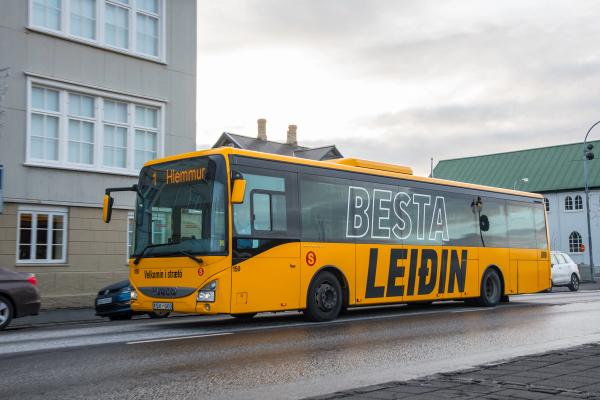
Akureyri Local System
Akureyri has its own local bus system (SVA) with routes serving main residential and commercial areas. Route A1 connects Brekka to Naustahverfi. Fares match those in Reykjavík, with single tickets at 600 ISK.
Taxis
Taxis are also available in Iceland, but they can be pretty expensive. They are a good option for short trips or if you're in a hurry, but they are not a practical choice for long-distance travel.
The starting fare is about 730 ISK (around $6), and you’ll pay roughly 351 ISK (about $2.80) for every kilometer you travel. If the driver needs to wait for you, the cost can add up quickly.

Ferries and Domestic Flights
While not officially "public transport," ferries and domestic flights are essential for reaching certain parts of Iceland, especially islands and remote regions.
Ferries
Several ferry services connect the mainland to inhabited islands across Iceland. The Viðey Ferry, run by Elding Adventure at Sea, travels between Reykjavík and Viðey Island with eight daily departures in summer (May 15-Aug 31) and weekend-only service in winter. Adult fares cost 2,400 ISK, youth tickets (ages 7-17) are 1,200 ISK, and children under 6 ride free. To reach the ferry terminal, take Strætó Route 5 to Skarfabakki for 670 ISK.
The Herjólfur Ferry connects Landeyjahöfn/Þorlákshöfn to Vestmannaeyjar with 2-4 daily sailings and a journey time of about 35 minutes from Landeyjahöfn. Adult one-way fares are 2500 ISK ($20), and you can reach the ferry by taking Strætó Route 52 from Mjódd to Landeyjahöfn for 6,670 ISK ($55).
For travelers heading to the Westfjords, the Baldur Ferry run by Sæferðir goes from Stykkishólmur to Brjánslækur via Flatey with two daily sailings in summer. The 2.5-hour journey costs around 7,396 ISK ($60) one-way for adults. If you go to Flately, the price is 5,047 ISK ($41) instead. You can reach Stykkishólmur via the Strætó Route 58 for 6,070 ISK ($50).
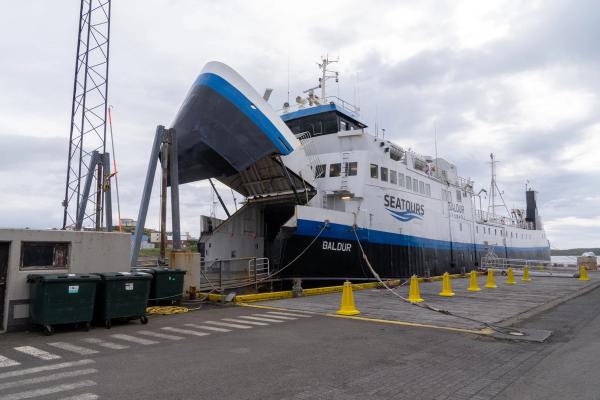
Domestic Flights
Domestic flights provide the fastest way to reach distant regions of Iceland, with Air Iceland Connect and Eagle Air operating from Reykjavík Domestic Airport near the city center. Popular routes include Reykjavík to Akureyri (45-60 minutes), Reykjavík to Ísafjörður in the Westfjords (40-50 minutes), and Reykjavík to Egilsstaðir in East Iceland (60 minutes).
Itineraries connecting Reykjavik and Akureyri can go for as little as $160 in August.
Practical Tips
When using ferries and flights in Iceland, book well in advance, especially during the summer. Always check operator websites or social media for weather updates, as services can change due to Iceland's weather conditions. If you have accessibility needs, research your options carefully, as some ferries have limited wheelchair access and may require help.
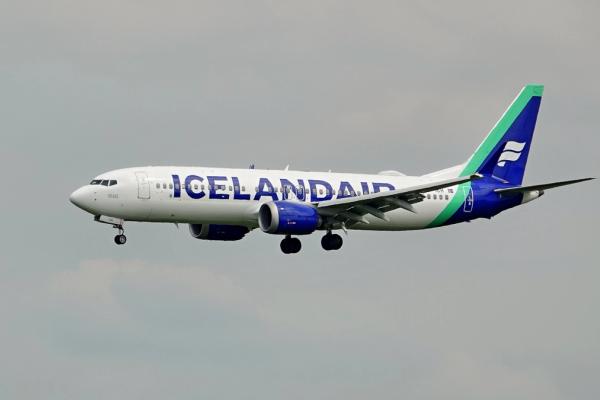
Regional Differences and Accessibility
Buses in urban vs rural areas are completely different in terms of schedules, accessibility, and more.
Urban vs. Rural Transport
Public transport availability varies greatly between urban and rural areas in Iceland. Reykjavík has an extensive network of 27 Strætó routes, night buses on weekends, and the Reykjavík City Card for unlimited travel. Smaller cities like Akureyri and Reykjanesbær have local systems with limited routes but regular service within town limits.
The situation changes in rural areas, where intercity routes are limited and many services run seasonally for tourists. Many remote areas have minimal or no public transport, which is why most visitors rent a car or a campervan to travel around the country.
Accessibility
Strætó offers discounted fares for disabled passengers at 70% off regular prices, but accessibility varies across the network. All buses in the Reykjavik area have a ramp to assist people in wheelchairs, although there’s space for just one wheelchair per bus. On the other hand, buses in the countryside don’t offer wheelchair access. Blind people travel for free on all buses in the Reykjavik area.
Ferry services have varying levels of accessibility as well. For example, Viðey Ferry has steep stairs that can be difficult for wheelchairs, while larger ferries like Herjólfur offer better facilities but may still require help depending on weather and sea conditions. Always contact the company before traveling, as their staff will do everything in their power to assist you.
Sustainability Efforts
Iceland is working toward more sustainable transport with several initiatives. Strætó has introduced electric buses in Reykjavík as part of the country's commitment to reducing carbon emissions. The proposed Borgarlína (Bus Rapid Transit) system aims to reduce car dependency in the Capital Region by providing faster, more efficient public transport options.
Despite these efforts, rural coverage remains limited, making it challenging to explore Iceland in a more eco-friendly way.

Practical Tips for Using Strætó
Despite Iceland being a country where most things work like clockwork, public transport, being so dependent on the weather, is not as reliable as we would want it to be. For that reason, planning your trip well ahead of time is key.
Planning Your Journey
- Successful travel on Iceland's public transport system requires advance planning. Visit straeto.is for schedules, maps, and fare information in English.
- The Klappið app is essential for real-time tracking, tickets, and journey planning.
- For the latest service updates, especially during bad weather, follow Strætó on X (@straeto) where cancellations and delays are posted promptly.
- Remember that season affects service availability. Summer (June to mid-September) offers more routes and higher frequency, making it the easiest time to explore Iceland by public transport. Winter services are more limited and subject to weather-related disruptions.
Saving Money
Public transport in Iceland isn't cheap, but several strategies can help manage costs:
- The Reykjavík City Card includes unlimited urban travel plus museum access and discounts on attractions, offering good value for city exploration.
- Look for discounted fares - youth (12-17), elderly, and disabled passengers pay 50% of the adult fare.
- Using digital tickets through the Klappið app helps avoid the fees that come with withdrawing money.
Travel Tips
- When planning intercity journeys, allow plenty of time - Route 57 from Reykjavík to Akureyri takes 8-10 hours, much longer than driving.
- Weather preparedness is essential even in summer; carry warm clothing when waiting at rural bus stops where shelter may be limited.
- For comprehensive coverage, combine Strætó with ferries or flights for accessing islands or remote areas not served by buses alone.
Using public transport offers cultural insights too. While Icelanders love their cars, riding buses and ferries provides opportunities to interact with locals and experience daily life from a different perspective, offering a more authentic and sustainable travel experience.

Getting Around in Practice: Sample Journeys
You see that using public transport as your main means of transportation is not the most practical or cheap option compared to having your own vehicle, but don’t feel discouraged. If you don’t want or can’t drive, this is a great way to explore the country. Let’s have a look at what a real itinerary would look like.
Reykjavík to Vík (South Coast)
Travelers heading to the black sand beaches of Vík can take Strætó Route 51 for $70 one-way. The journey takes about 3 hours and runs daily during the summer months. Book in advance through the Klappið app to secure your seat, as this popular tourist route can fill up quickly in peak season.
Reykjavík to Vestmannaeyjar (Westman Islands)
Reaching the Westman Islands requires combining bus and ferry travel. First, take Strætó Route 52 from Reykjavík to Landeyjahöfn for $5o, then connect to the Herjólfur ferry to Vestmannaeyjar for an additional $20. The total journey costs $70 one-way and takes about 3.5 hours in good conditions. Always check ferry schedules in advance, as they change based on weather and season. In rough weather, the ferry may depart from Þorlákshöfn instead, adding travel time.
Keflavík Airport to Reykjavík
If you came to Iceland by plane, you landed at Keflavik Airport. To Reykjavik, take Strætó Route 55. The fare is $20 ISK for a 45-minute journey, with regular service coordinated with flight arrivals and departures. Purchase tickets through the Klappið app to avoid queues at the airport and ensure a smooth start to your Icelandic adventure.
Reykjavík to Akureyri
If you don’t want to drive, you have two main options for reaching “The Capital of the North”. Strætó Route 57 costs $107 one-way and takes 8-10 hours. The route offers scenic views, but it will test your patience. For those prioritizing speed, domestic flights cost between $80 and $150 one-way and take just 45-60 minutes. Booking well in advance is essential for better rates, especially in summer.

Conclusion
Navigating Iceland without a car is possible with some planning and flexibility. Strætó buses provide the backbone of public transport, serving Reykjavík, Akureyri, and major intercity routes with fares ranging from $5,50 for local journeys to $140 for longer distances.
Ferries and domestic flights, while not technically public transport, complement the bus network and are essential for accessing islands and remote regions.

